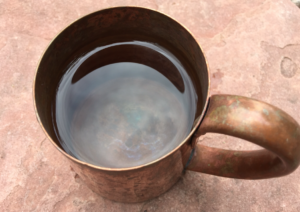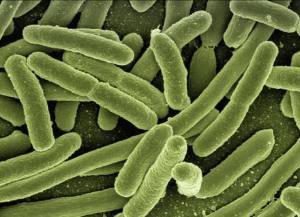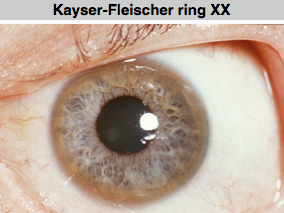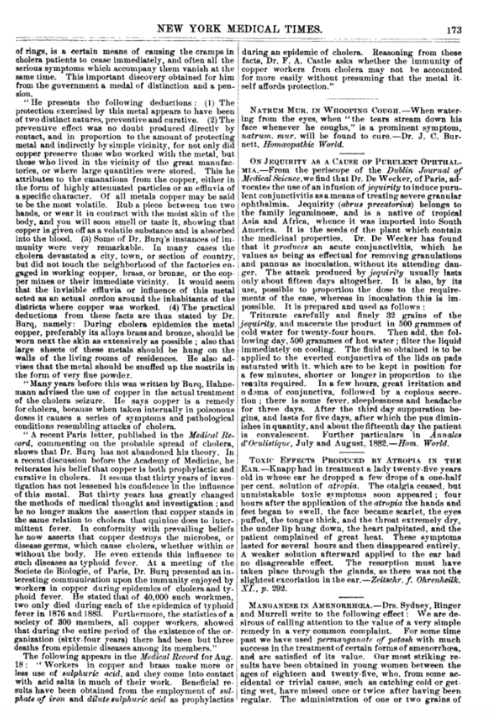 by Rita Wilhelm
by Rita Wilhelm
If you want to learn more about copper and health, you’ve come to the right place. I’ve gone ahead and done the deep research for you.
Here’s the scoop on copper.
But first, my disclaimer:
| Disclaimer I am a nutritionist and not a medical doctor. Your health is between you and your doctor. I am not diagnosing or curing anything. I’m just presenting my research to you. |
What Does Copper Do?
Copper is an essential trace mineral that is found in all body tissues. It enables the body to make red blood cells, maintain nerve cells and strengthen the immune system. (R)
It plays an important role in the electrical circuitry of the spinal cord and brain, as copper is conductive. (Read: Do We Have Electricity In Our Body?).
Copper is considered to be an anti-aging mineral, which is why it is used in the beauty industry.
Even often skeptical doctors are touting copper’s ability to combat the ravages of time. “Copper definitely plays an important role in maintaining healthy skin,” says dermatologist Joshua Zeichner, director of cosmetic and clinical research at Mount Sinai’s Department of Dermatology in New York. “It helps to develop collagen and elastin, which maintain the strength of the skin, and it promotes the production of skin-plumping hyaluronic acid.” (Translation: less sagging and fewer lines.) “It also has antibacterial and antifungal properties, which help prevent infections,” he adds, which is why it has been used in wound care since the ’60s (and shows high hopes for acne treatment too).
Harper’s Bazaar
Copper is required to make collagen and elastin, which form our connective tissues. (R)
Copper is needed to make ceruloplasmin, which plays a very important role in iron metabolism.
Copper is needed to make important antioxidants such as superoxide dismutase, which reduces inflammation.
Copper is necessary for wound healing, healthy skin and healthy hair. (R)
Copper may be a key in burning fat:

We find that copper is essential for breaking down fat cells so that they can be used for energy,” said Chang. “It acts as a regulator. The more copper there is, the more the fat is broken down. We think it would be worthwhile to study whether a deficiency in this nutrient could be linked to obesity and obesity-related diseases.
Science X
A copper deficiency may be the leading cause of coronary heart disease. (R)
A copper deficiency may be involved with Alzheimer’s disease. (R)
Low copper is linked to elevated cholesterol, triglycerides and blood pressure. (R, R)
Children who are deficient in copper may have poor growth and motor skills.
Children with copper deficiency through malnutrition or another condition may have vascular aneurysms, central nervous system problems, stunted growth, poor muscle tone and muscle weakness, and hypothermia.
University of Rochester Medical Center
It’s also possible that a copper deficiency plays a role in histamine intolerance. (R)
And, copper’s antibiotic nature helps to protect us from infections.
Copper Deficiency Symptoms

- Anemia
- Fatigue and weakness
- Memory and learning difficulties
- Poor balance (R)
- A low level of white blood cells called neutrophils (neutropenia)
- Osteoporosis
- Paleness
- Gray hair
- Brittle or kinky hair (R)
- Neuropathy
- Myelopathy (spinal cord injury) (R)
Most of the Population in the U.S. May be Copper Deficient
The Food and Nutrition Board found that just 25 percent of the U.S. population gets enough copper daily. That means that in the United States, 3 out of 4 people are deficient in copper. (R)
The current recommended daily intake of copper is .9 milligrams.
Scientists however, are reevaluating the minimum requirements. Studies are now finding that the current minimum requirement is too low, and that minimum daily requirements may need to be increased to about 2.6 mg per day. (R)
It’s easy to be deficient in copper if one is on a low-carb or ketogenic diet.
Ground beef for instance, contains some copper. But because it contains a high amount of iron and zinc, it can make a copper deficiency worse.
In fact, it was found that supplemental zinc can cause both a copper deficiency and anemia. (R)
And as I discussed in my last article “ You May Want to Think Twice About that Iron Supplement ”, too much iron from enriched flour and fortified foods, supplements, red meat and cast iron pans, along with certain hereditary conditions, can also cause an iron-copper imbalance, and create a copper deficiency.
Other causes of copper deficiency include bariatric surgery, celiac disease, and inflammatory bowel disease. (R)
Basically, if you are not regularly eating brain, kidney, heart, liver, shellfish, soy protein, a lot of nuts and seeds, potatoes or cocoa, chances are you may not be getting enough copper.
The Challenge of Getting in Enough Copper
 So what does it take to get the daily requirement of copper in without eating organ meats like brain and liver?
So what does it take to get the daily requirement of copper in without eating organ meats like brain and liver?
It can be a challenge.
Mushrooms are considered to be an excellent source of copper. But, that would take 3 cups of mushrooms to get to the recommended minimum intake.
Or, a cup of cashews.
Potatoes are an excellent source of copper, but it’s still going to take 2 large potatoes to get there.
Chocolate is probably my favorite source of copper, but it is still going to take about four tablespoons of cocoa to meet the daily requirement of copper.
Drinking copper water is probably one of the easiest ways to take in copper.
What is Copper Water?
 Copper water can be a source of copper. Copper water is water that has been sitting in a copper vessel, (whether it’s in a copper water bottle, copper cup, or other copper container), for at least 4 hours.
Copper water can be a source of copper. Copper water is water that has been sitting in a copper vessel, (whether it’s in a copper water bottle, copper cup, or other copper container), for at least 4 hours.
When water sits in a copper vessel, copper ions leach into the water in a process called the Oligodynamic Effect. These copper ions energize the water with a slight increase in pH. (R)
One of the reasons people have been drinking copper water for thousands of years, is because it purifies drinking water. In fact, holding water in a copper vessel for just 4 hours, will kill bacteria, fungi, and mold. It also inactivates many viruses.
This makes it an inexpensive and energy efficient method of providing clean water in developing countries. It is also something to keep in mind if clean water is hard to come by.
The amount of copper that does get leached into the water overnight, is still well within the World Health Organization’s safety limits.
The amount of copper leached into the water after overnight storage in a copper pot or a glass bottle with a copper device was less than 475 parts per billion, which is well within the safety limits prescribed by the WHO. The device is inexpensive, reusable, easy to maintain, durable, does not need energy to run and appears to be safe. It has the potential to be used as a household water purification method for removing enteric bacteria, especially in developing countries.
(R)
Does a High Serum Copper Level Mean Copper Toxicity?
I belong to many Facebook groups, and notice that many people think they have copper toxicity because their blood copper levels are high.
This is something that can be confusing, even when reading studies.
One of the reasons why this is confusing, is because of what is called the “acute phase reaction.”
This reaction occurs when the body is dealing with a microbial infection or trauma.
Basically, once the body knows that there is an infection, it removes iron from the bloodstream, to keep it away from bacteria. (Iron is very desirable to bacteria, and will cause bad bacteria to flourish.)
During this reaction, copper levels increase, as copper plays an important role in fighting infections. The body will use copper stores from the liver to deal with the infection, which can deplete liver stores. Copper does need to be continuously be replaced (for most people).
It is important to note that serum copper largely reflects serum ceruloplasmin and is not a sensitive indicator of copper nutritional status. Serum ceruloplasmin levels are known to increase by 50% or more under certain conditions of physical stress, such as trauma, inflammation, or disease. Because over 90% of serum copper is carried in ceruloplasmin, which is increased in many inflammatory conditions, elevated serum copper may simply be a marker of inflammation that accompanies atherosclerosis.
The Linus Pauling Institute at Oregon State University
Menke’s and Wilson’s Disease – Copper Toxicity
Normally speaking, the body should be able to remove excess copper from the body via feces, sweat and urine.
However, there are genetic conditions in which the body does not properly metabolize copper.
One such disease is Menkes, and those born with Menkes typically don’t survive infancy.
Another genetic condition is Wilson’s disease. This is a rare condition that occurs in about 1 in 30,000 people.
Wilson disease is a genetic disorder that prevents the body from removing extra copper, causing copper to build up in the liver, brain, eyes, and other organs. Without treatment, high copper levels can cause life-threatening organ damage.
U.S. Department of Health and Human Services
A telltale sign of Wilson’s disease are Kayser-Fleischer rings around the iris. (See below picture.)

Another diagnostic test for Wilson’s disease is a high urine copper levels. (R)
If you think that you may have Wilson’s disease, do not drink copper water.
Copper Levels in Hair Mineral Analysis
 Is hair mineral analysis a good way to measure copper levels?
Is hair mineral analysis a good way to measure copper levels?
Not necessarily.
There are many factors that impact the amount of copper that is found in hair. According the Textbook of Natural Medicine, it is an unreliable measurement for clinical application.
Oral contraceptive use is associated with decreased hair copper and increased serum copper. High hair copper levels are associated with being female, lactation, idiopathic scoliosis, and pregnancy in some, but not all, studies.
Textbook of Natural Medicine
Surprisingly, conditions that affect systemic copper status have been shown not to affect hair levels. Copper deficiency, Wilson’s disease, and cirrhosis do not significantly alter hair copper content.
Hair copper levels also vary with geographic location. However, fur and liver copper values have been found to correlate in rats, and one study reported that supplemental copper raises hair copper levels.
Hair color also has been found to influence the levels of copper in the hair. At this time, hair copper measurement appears unreliable for clinical application.
Historical Use of Copper as a Healing Agent
Copper has a rich history of being used as a healing agent.
The first recorded medical use of copper is found in the Smith Papyrus, which is an Egyptian medical text, written between 2600 and 2200 B.C. It records the use of copper to sterilize chest wounds and to sterilize drinking water. (R)
People in Asia have been using copper vessels to store their water for thousands of years. In Ayervedic medicine, copper water (Tamra Jal ) is said to balance all three Doshas (Vata, Pitta and Kapha).
Hippocrates recommended copper to treat leg ulcers and varicose veins.
 The Greeks would put copper shavings into battle wounds, to ward off infection.
The Greeks would put copper shavings into battle wounds, to ward off infection.
The Aztecs used copper water and herbs to treat sore throats.
Ancient India and Persia used copper to treat lung diseases. (R)
France used copper salts and copper vessels to green vegetables in the early 1900s. France has also used copper on their grapes to control fungus. (Perhaps this is one of the reasons for the success of the Mediterranean diet.)
I found an interesting article in a medical journal from 1884 that describes how copper mine workers and people who worked in copper factories were protected from the cholera epidemics. It also talks about how applying copper bands around sick cholera patients would stop cholera symptoms. Here are a few excerpts:

Written in the year 1884:
“Fifty years ago [and keep in mind this was written in 1884, so 50 years before that] Hahnemann wrote: ‘The use of copper, combined with a mild and regular regimen and cleanliness, is the most certain and efficacious preventive. He adds: ‘it has been proved in Hungary that a plate of copper worn next the skin will preserve one from the infection, as I have been assured by several authentic reports from that country.’
The Medical Times Volume 11 (1884)
In support of these statements I will quote from the writings on an eminent allopathic physician of Paris, Dr. Burq, whose fame as an investigator of the medicinal power of metals is worldwide. Thirty years ago he ascertained, by numerous experiments made in the hospitals under the supervision of the head physicians, that the application of copper to the limbs, in the form of rings, is a certain means of causing the cramps in cholera patients to cease immediately, and often all the serious symptoms which accompany them vanish at the same time. This important discover obtained for him from the government a medal of distinction and a pension.
He presents the following deductions:
(1) The protection exercised by this metal appears to have been of two distinct natures, preventative and curative.
(2) The preventative effect was no doubt produced directly by contact, and in proportion to the amount of protecting metal and indirectly by simple vicinity, for not only did copper preserve those who worked with the metal, but also those who lived in the vicinity of the great manufacturers, or where large quantities were being stored.
[…]
In many cases the cholera devastated a city, town, or section of the country, but did not touch the neighborhood of the factories engaged in working copper, brass, or bronze, or the copper mines or their immediate vicinity.
[…]
During cholera epidemics the metal copper, preferably its alloys brass and bronze, should be worn next to the skin as extensively as possible; also that large sheets of these metals should be hung on the walls of the living rooms of residences.
Here is another interesting article from a 1922 medical journal, that I that I feel really speaks to the safety of copper.
It’s about copper mine workers who actually turned green because they were so saturated with copper. Yet they lived long and healthy lives:
Nothing could be more striking than the saturation with this metal of the workers in some branches of the copper industry, for not only is the hair green, but the urine and even the bones are of the same color; yet colonies of such workers have been observed with the greatest care and for generations, always with the verdict that no injurious effects can be ascribed to the copper. Such copper-saturated men live as long as others, are robust and active, have no special symptoms ascribable to copper, are subject to no special diseases, and may work in an atmosphere full of copper dust until they are octogenerians.
Journal of the American Medical Association, Volume 78 (1922)
Update: 3/9/20 Copper and Coronavirus
Please read our article: Why Copper May Help Protect Us from Coronavirus
The Scoop on Copper Water Bottles
Is it Safe to Drink from Copper Water Bottles?
Generally speaking, drinking copper water is safe for most people, as excess copper has excretion pathways.
A rare genetic condition called Wilson’s disease is about the only reason from my perspective, on why someone should not drink water from a copper bottle.
As mentioned above, the World Health Organization has found that the amount of copper found in water that is stored in a copper vessel for 16 hours is well within the healthy limits.
And we from anecdotal evidence above, that copper miners and people who worked in copper factories were protected from the cholera epidemics.
And notably, copper miners that were completely green from copper saturation, still managed to live long healthy lives, while still working in the copper mines in their eighties.
Copper Water Side Effects
Because copper does kill bacteria, fungi, mold and parasites, you might start slow when you first start drinking from a copper water bottle or cup, just to control any potential Herxheimer reaction that may be caused by the death of these microbes.
A Jarisch–Herxheimer reaction is a reaction to endotoxin-like products released by the death of harmful microorganisms within the body during antibiotic treatment. Efficacious antimicrobial therapy results in lysis (destruction) of bacterial cell membranes, and in the consequent release into the bloodstream of bacterial toxins, resulting in a systemic inflammatory response.
Wikipedia
FAQs
Here are some other frequently asked questions and tidbits about copper water bottles.
How To Use Copper Water Bottle The First Time
Before using your water bottle, rinse the bottle using a natural acidic solution such as lemon and water.
Traditional methods of cleaning a copper bottle is by rubbing the copper with a mixture of salt and tamarind paste. Nowadays, you can use fresh lemon juice, salt or baking soda and vinegar to clean it. Allow it to stand in bottle overnight or at least 8 hours for best effects. Rinse in the morning.
Times of India
How To Clean A Copper Water Bottle
Copper is naturally antibacterial and antifungal, so keep in mind that your copper water bottle is sort of self-cleaning, in that it’s already taken care of the microbes.
Of course, you will still need to remove solids.
Also, copper naturally discolors to a patina when it oxidizes. You can easily shine that up again.
Here is a video showing you how you can clean a copper water bottle using hot water, vinegar and salt:
Can A Copper Water Bottle Be Kept In The Fridge?
Yes, you can keep a copper water bottle in the fridge.
Should You Put Hot Water In A Copper Bottle?
Yes, you can put hot water in a copper bottle.
Keep in mind that many people have hot water pipes made out of copper, so hot water and copper is nothing new.
Be aware that hot water will also heat up the outside of your copper water bottle, so be careful not to burn yourself.

